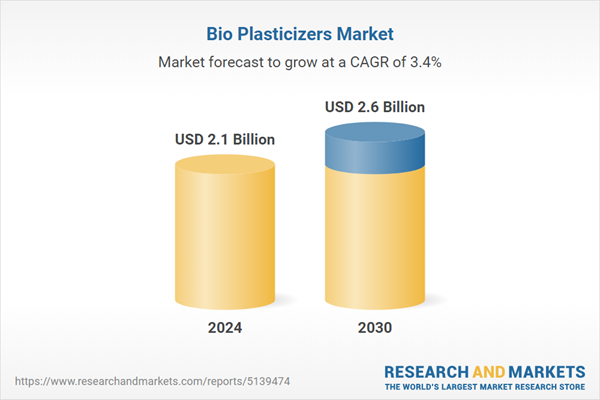The global market for Bio Plasticizers was valued at US$2.1 Billion in 2024 and is projected to reach US$2.6 Billion by 2030, growing at a CAGR of 3.4% from 2024 to 2030. This comprehensive report provides an in-depth analysis of market trends, drivers, and forecasts, helping you make informed business decisions. The report includes the most recent global tariff developments and how they impact the Bio Plasticizers market.
Segments: Type (Epoxides, Sebacates, Glycerol Esters, Succinic Acid, Other Types); Application (Flooring & Walls, Film & Sheet Coverings, Wires & Cables, Coated Fabrics, Consumer Goods, Other Applications).
Geographic Regions/Countries: World; United States; Canada; Japan; China; Europe (France; Germany; Italy; United Kingdom; and Rest of Europe); Asia-Pacific; Rest of World.
The analysts continuously track trade developments worldwide, drawing insights from leading global economists and over 200 industry and policy institutions, including think tanks, trade organizations, and national economic advisory bodies. This intelligence is integrated into forecasting models to provide timely, data-driven analysis of emerging risks and opportunities.
Global Bio Plasticizers Market - Key Trends and Drivers Summarized
Why Are Bio Plasticizers Becoming the Go-To Solution in the Plastics Industry?
Bio plasticizers are quickly gaining traction in the plastics industry as a sustainable and environmentally friendly alternative to traditional petroleum-based plasticizers. Derived from renewable resources such as vegetable oils, starches, and other natural materials, bio plasticizers offer a greener solution compared to conventional plasticizers like phthalates, which are under increasing scrutiny for their environmental and health impacts. These eco-friendly additives enhance the flexibility, durability, and workability of plastic products, making them essential in the production of flexible PVC, synthetic rubber, and various other polymeric materials. As environmental concerns and regulatory pressures mount, industries are increasingly turning to bio plasticizers to reduce their ecological footprint and meet consumer demands for safer, non-toxic products. This shift is particularly evident in sectors such as packaging, medical devices, toys, and automotive interiors, where the benefits of bio plasticizers align with the growing emphasis on sustainability and health.How Are Breakthrough Technologies Revolutionizing Bio Plasticizers?
The evolution of bio plasticizers is being driven by cutting-edge technological advancements, which are setting new standards in the plastics industry. Innovations in biotechnology and green chemistry have led to the creation of bio plasticizers that not only match but often exceed the performance of their traditional counterparts. For example, the development of new bio-based esters and epoxidized vegetable oils has resulted in plasticizers with superior thermal stability, reduced volatility, and enhanced compatibility with a wide range of polymers. These high-performance bio plasticizers are finding increasing application in demanding environments, such as automotive and construction materials, where durability and reliability are critical. Additionally, the incorporation of bio plasticizers into advanced polymer blends and composites is opening up new possibilities across various industries. As research continues to yield new bio-based raw materials and more efficient production processes, bio plasticizers are expected to become even more cost-effective, further accelerating their adoption across the globe.What New Market Dynamics Are Shaping the Future of Bio Plasticizers?
The future of the bio plasticizers market is being shaped by several dynamic trends that reflect broader shifts in the global plastics industry. One of the most significant trends is the growing demand for non-toxic, phthalate-free plasticizers, spurred by increasing awareness of the health risks associated with conventional plasticizers. This has led to a surge in the use of bio plasticizers in applications where safety is paramount, such as food packaging, medical devices, and children’s products. Another key trend is the rising influence of circular economy principles, which prioritize the use of renewable resources and the minimization of waste. Bio plasticizers, derived from renewable sources, align perfectly with these principles and are becoming a preferred choice for companies looking to enhance their sustainability credentials. Furthermore, regulatory pressures are intensifying globally, with governments and international bodies tightening restrictions on hazardous chemicals in plastics. This regulatory shift is driving manufacturers to adopt bio plasticizers not only to comply with these regulations but also to meet the growing consumer demand for greener products. As the market for bio-based chemicals continues to expand, the availability of bio plasticizers is increasing, leading to greater innovation and a broader range of applications.What Are the Factors Fueling the Rapid Expansion of Bio Plasticizers Market?
The growth in the bio plasticizers market is driven by several factors that are catalyzing the adoption of these sustainable solutions across multiple industries. One of the primary drivers is the rising demand for environmentally friendly and non-toxic plasticizers, especially in regions like Europe and North America, where regulatory frameworks are particularly stringent. Additionally, the push for sustainability within the automotive, construction, and consumer goods sectors is propelling the use of bio plasticizers as manufacturers strive to reduce the environmental impact of their products. Technological advancements have also played a crucial role in this market expansion, with innovations in bio-based raw materials and production processes enhancing the performance and cost-effectiveness of bio plasticizers. This has made them a viable alternative to traditional plasticizers in a wider range of applications. Moreover, the growing consumer preference for eco-friendly products is encouraging brands to incorporate bio plasticizers into their packaging and product formulations, thereby creating new market opportunities. As the bio-based chemicals industry continues to grow, the increasing availability of bio plasticizers is further supporting market expansion, making these products more accessible and attractive to manufacturers worldwide.Report Scope
The report analyzes the Bio Plasticizers market, presented in terms of units. The analysis covers the key segments and geographic regions outlined below.Segments: Type (Epoxides, Sebacates, Glycerol Esters, Succinic Acid, Other Types); Application (Flooring & Walls, Film & Sheet Coverings, Wires & Cables, Coated Fabrics, Consumer Goods, Other Applications).
Geographic Regions/Countries: World; United States; Canada; Japan; China; Europe (France; Germany; Italy; United Kingdom; and Rest of Europe); Asia-Pacific; Rest of World.
Key Insights:
- Market Growth: Understand the significant growth trajectory of the Epoxides segment, which is expected to reach US$990.7 Million by 2030 with a CAGR of a 3.8%. The Sebacates segment is also set to grow at 3.1% CAGR over the analysis period.
- Regional Analysis: Gain insights into the U.S. market, valued at $573.8 Million in 2024, and China, forecasted to grow at an impressive 3.2% CAGR to reach $410.9 Million by 2030. Discover growth trends in other key regions, including Japan, Canada, Germany, and the Asia-Pacific.
Why You Should Buy This Report:
- Detailed Market Analysis: Access a thorough analysis of the Global Bio Plasticizers Market, covering all major geographic regions and market segments.
- Competitive Insights: Get an overview of the competitive landscape, including the market presence of major players across different geographies.
- Future Trends and Drivers: Understand the key trends and drivers shaping the future of the Global Bio Plasticizers Market.
- Actionable Insights: Benefit from actionable insights that can help you identify new revenue opportunities and make strategic business decisions.
Key Questions Answered:
- How is the Global Bio Plasticizers Market expected to evolve by 2030?
- What are the main drivers and restraints affecting the market?
- Which market segments will grow the most over the forecast period?
- How will market shares for different regions and segments change by 2030?
- Who are the leading players in the market, and what are their prospects?
Report Features:
- Comprehensive Market Data: Independent analysis of annual sales and market forecasts in US$ Million from 2024 to 2030.
- In-Depth Regional Analysis: Detailed insights into key markets, including the U.S., China, Japan, Canada, Europe, Asia-Pacific, Latin America, Middle East, and Africa.
- Company Profiles: Coverage of players such as ACS Technical Products, Inc., Avient Corp., Cargill, Inc., DIC Corporation, Dow, Inc. and more.
- Complimentary Updates: Receive free report updates for one year to keep you informed of the latest market developments.
Some of the 31 companies featured in this Bio Plasticizers market report include:
- ACS Technical Products, Inc.
- Avient Corp.
- Cargill, Inc.
- DIC Corporation
- Dow, Inc.
- Emery Oleochemicals Group
- Evonik Industries AG
- Lanxess AG
- Matrica S.p.A.
- Teknor Apex Company
Tariff Impact Analysis: Key Insights for 2025
Global tariff negotiations across 180+ countries are reshaping supply chains, costs, and competitiveness. This report reflects the latest developments as of April 2025 and incorporates forward-looking insights into the market outlook.The analysts continuously track trade developments worldwide, drawing insights from leading global economists and over 200 industry and policy institutions, including think tanks, trade organizations, and national economic advisory bodies. This intelligence is integrated into forecasting models to provide timely, data-driven analysis of emerging risks and opportunities.
What’s Included in This Edition:
- Tariff-adjusted market forecasts by region and segment
- Analysis of cost and supply chain implications by sourcing and trade exposure
- Strategic insights into geographic shifts
Buyers receive a free July 2025 update with:
- Finalized tariff impacts and new trade agreement effects
- Updated projections reflecting global sourcing and cost shifts
- Expanded country-specific coverage across the industry
Table of Contents
I. METHODOLOGYII. EXECUTIVE SUMMARY2. FOCUS ON SELECT PLAYERSIII. MARKET ANALYSISIV. COMPETITION
1. MARKET OVERVIEW
3. MARKET TRENDS & DRIVERS
4. GLOBAL MARKET PERSPECTIVE
UNITED STATES
CANADA
JAPAN
CHINA
EUROPE
FRANCE
GERMANY
ITALY
UNITED KINGDOM
REST OF EUROPE
ASIA-PACIFIC
REST OF WORLD
Companies Mentioned (Partial List)
A selection of companies mentioned in this report includes, but is not limited to:
- ACS Technical Products, Inc.
- Avient Corp.
- Cargill, Inc.
- DIC Corporation
- Dow, Inc.
- Emery Oleochemicals Group
- Evonik Industries AG
- Lanxess AG
- Matrica S.p.A.
- Teknor Apex Company
Table Information
| Report Attribute | Details |
|---|---|
| No. of Pages | 189 |
| Published | April 2025 |
| Forecast Period | 2024 - 2030 |
| Estimated Market Value ( USD | $ 2.1 Billion |
| Forecasted Market Value ( USD | $ 2.6 Billion |
| Compound Annual Growth Rate | 3.4% |
| Regions Covered | Global |









